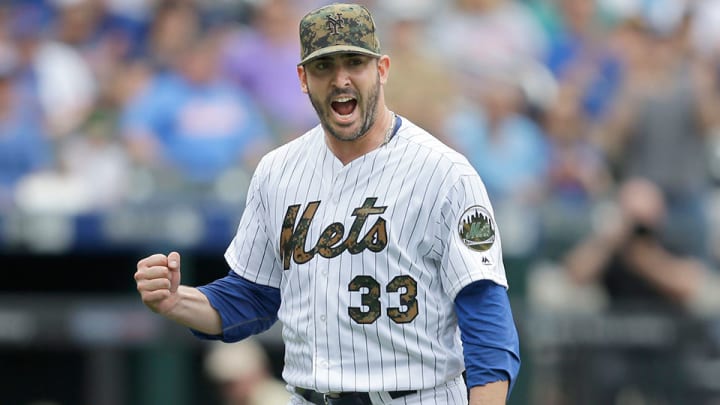Sigh of relief: Matt Harvey returns to form for Mets against White Sox

Follow your teams on the go or at home. Personalize SI with our new App. Install on iOS or Android.
At least for the moment, it would appear Matt Harvey is fixed. On Monday afternoon against the White Sox, the 27-year-old righty moved past a dreadful three-start stretch by taking a perfect game into the fifth inning and throwing his longest—and by far best—outing of the season, as the Mets won a 1–0 squeaker at Citi Field.
After allowing 19 runs (16 earned) and 27 hits in 13 1/3 innings over his previous three turns against the Rockies and Nationals (twice), Harvey was back to pitching like the staff ace on Monday, throwing seven scoreless innings, allowing just three base runners and striking out six. He retired the first 13 batters he faced before yielding a one-out single to J.B. Shuck in the fifth inning but erased him via Wilmer Flores's unassisted double play; Flores, playing first base for just the third time in his major league career, made a diving catch on a ball scorched by Brett Lawrie and then touched first.
After facing the minimum number of batters through six innings, Harvey worked into and out of a jam in the seventh, walking Adam Eaton and giving up a single to Jose Abreu to start the inning. The White Sox gave him an out via Melky Cabrera's sacrifice bunt, then Harvey got Todd Frazier to hit a pop foul to Flores and Shuck to ground out on his 87th and final pitch of the afternoon. Neil Walker homered off Jose Quintana—who had thrown a strong outing himself—to lead off the seventh, providing the only run of the afternoon, and Addison Reed and Jeurys Familia worked scoreless innings in relief to finish the job.
Harvey summoned his best velocity of the season. Via Baseball Savant's PITCHf/x data, he had not reached 98 mph with his fastball this year, something he did 122 times last year. Via MLB.com's Mike Petriello, Harvey threw his four hardest pitches of the season in terms of velocity on Monday, all in the 97.9–98.5 mph range. Brooks Baseball—which calculates release velocity slightly differently than Baseball Savant (which is run by MLB.com), based on a 55-foot distance from the plate rather than a 50-foot distance—reported Harvey's top four-seam fastball velocity at 99.2 mph and his average four-seamer velocity as 96.5, matching his May 8 start against the Padres for his highest of the season. In his postgame comments—yes, he did make postgame comments, unlike last time—Harvey noted that he was staying over the rubber longer.
Dodgers’ Utley tortures Mets, records 5 RBIs as Syndergaard gets tossed
That May 8 start was Harvey’s most recent quality start prior to his slide. Monday's turn was his first time pitching into the seventh inning this season, let alone completing the seventh. More than just fast, he was efficient, needing more than 12 pitches only in the second inning (15) and seventh (17), throwing 61 of his 87 pitches for strikes and getting ahead of 14 of the 23 batters he faced via first-pitch strikes; he fell behind just one batter 2–0 and went to a three-ball count just twice. Harvey got 10 swings and misses—six of them with the four-seamer—and mixed in his two-seamer, changeup, slider and curve in roughly equal proportions, with manager Terry Collins citing his changeup as his second-best pitch in his postgame comments. Via Collins, Harvey's energy and confidence were also different from his recent starts.
One factor that may have helped: Harvey worked with backup catcher Rene Rivera for the first time rather than Kevin Plawecki (who has caught him seven times this season) or the now-injured Travis d'Arnaud. All three are good pitch framers according to Baseball Prosepctus' data, but for whatever reason, Harvey worked better with the more experienced backstop. As Collins told reporters, the choice was simply one based on his having used Plawecki for Sunday night's game, but it wouldn't be a surprise if the pairing continued.
Harvey did catch one other significant break in addition to Flores's double play and Cabrera's bunt: He got a strikeout in the second inning on a pitch that hit Lawrie on the hand. Lawrie tried to check his swing, and while it looked as though he held up, the umpires ruled that he went around.
Which 1986 Mets players deserve to have their numbers retired?
Facing the White Sox was a break unto itself for Harvey. The team came in having lost 12 of 15—falling out of first place in the AL Central—and is batting .239/.287/.367 in that span. Chicago's lineup is heavy in righties, and Harvey came in having fared much better against same-siders (.791 OPS vs. 1.012 against lefties) this year. Of the three Sox hitters to bat against Harvey from the left side, switch-hitting Jimmy Rollins and lefty-swinging Alex Avila had particularly struggled against righties to date. While Harvey threw the best start of his career against the Sox back on May 7, 2013—a one-hit, 12-strikeout shutout in which he retired the first 20 hitters—nobody from that lineup remains with the Sox, with Rollins and Frazier the only players on the team who had taken more than four plate appearances against him.
With regular first baseman Lucas Duda on the disabled list due to a stress fracture in his lower back and David Wright likely to head there due to a herniated disc in his neck, the Mets are already playing at far less than full strength and are averaging just 2.96 runs per game this month. But while it was only one start, Harvey’s rebound leaves them one less thing to worry about.
